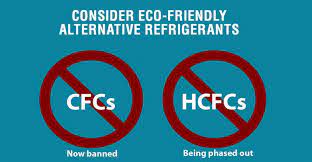COURTESY : www.rferl.org/
Cfc reduction
Washington, 13 March 1997 (RFE/RL) – Russia’s success in reducing the use of chemicals which damage the ozone layer has had an ironic effect of undercutting the global effort at eliminating those environmentally damaging compounds, according to the World Bank.
A world-wide coordinated program to stop the production of ozone depleting substances, mostly CFCs (chlorofluorocarbons) used in aerosol cans and refrigerators, was launched in 1991. The collapse of the Soviet Union and its economy forced Russia to postpone its planned compliance. But it was found that the economic crisis had helped the country reduce consumption of CFCs by half to between five and ten thousand tons.
The unfortunate side of that is that Russia is still producing 35,000 to 40,000 tons of the chemicals and the drop in domestic consumption, according to World Bank environmental officials, has pushed the excess onto black markets around the world.
Kenneth Newcome, the bank’s senior environmental advisor, says the Russian surplus is showing up on black markets in the United States, Western Europe, and “alarmingly” now in Latin America.
“The entrance of Russian black market CFCs has pushed the price so low that the alternatives no longer become attractive,” he says. This Russian leakage is completely undermining the world wide CFC program financed mostly by OECD (Organization for Economic Cooperation and Development) countries, says Newcome.
Newcome spoke to journalists in Washington this week in a briefing on the bank’s environmental activities. He said the world has to be “vigilant” that global agreements are working effectively and that any “gaps in the framework” are fixed in a timely manner.
That’s what the World Bank is doing in the Russian CFC program, says Newcome, stepping in to mobilize funds to help the country close down the largest remaining CFC production facilities in Europe.
Russia has nearly 50 percent of the global production capacity outside the major industrial nations for CFCs — or about 140,000 tons — says Newcome, although fortunately its actual production is only about 28 percent of that. Domestic demand is already down to less than a third of production, he says.
So the bank has reached a draft agreement with Russia, and between the Russian government and the seven major production companies of CFCs in Russia, to close down all CFC production in Russia over the next 18 months.
To be implemented, however, the international community has agreed to pay $27 million to compensate the companies for the actual costs of social adjustment and foregone profits on CFCs.
The bank estimates that illegal CFC production is worth at least $300 million a year at the moment, so the $27 million program to stop a major leak in the international system is “a pretty cheap buy-off.”
Unfortunately, he says, donor nations have only come up with about half the needed total, around $15 million, from the United States, the United Kingdom and the Nordic nations. Germany, Japan and a number of other major countries are still “considering” donations.
As soon as the money is in place, Newcome says, the program will phase out CFCs and help enterprises in the fire protection, solvents and non-insulating foam sectors adopt to environmentally friendly chemicals that won’t harm the ozone layer.
Andrew Steer, director of the World Bank’s environmental department, says this pro-active stepping-in is an example of the bank’s new approach of finding real solutions to real problems.
Steer says the World Bank has become the largest financier of environmental programs, but that it is clear that public money alone will never be able to meet the global needs. Newcome says the bulk of the money must come from private sources, catalyzed by the efficient use of the “precious public fund
Radio Free Europe/Radio Liberty © 2022 RFE/RL, Inc. All Rights Reserved.
MD




